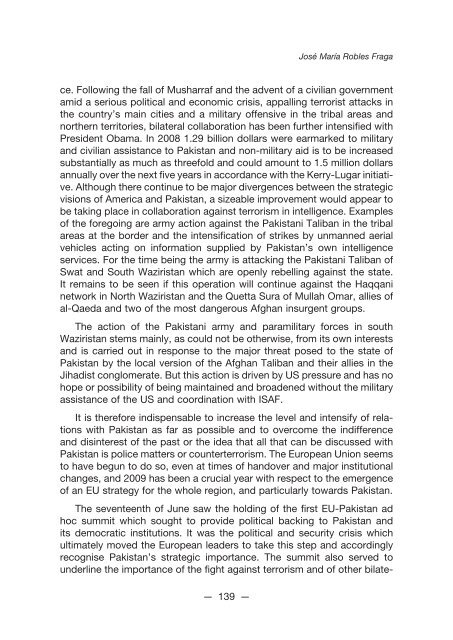Strategic Panorama 2009 - 2010 - IEEE
Strategic Panorama 2009 - 2010 - IEEE
Strategic Panorama 2009 - 2010 - IEEE
You also want an ePaper? Increase the reach of your titles
YUMPU automatically turns print PDFs into web optimized ePapers that Google loves.
José María Robles Fraga<br />
ce. Following the fall of Musharraf and the advent of a civilian government<br />
amid a serious political and economic crisis, appalling terrorist attacks in<br />
the country’s main cities and a military offensive in the tribal areas and<br />
northern territories, bilateral collaboration has been further intensified with<br />
President Obama. In 2008 1.29 billion dollars were earmarked to military<br />
and civilian assistance to Pakistan and non-military aid is to be increased<br />
substantially as much as threefold and could amount to 1.5 million dollars<br />
annually over the next five years in accordance with the Kerry-Lugar initiative.<br />
Although there continue to be major divergences between the strategic<br />
visions of America and Pakistan, a sizeable improvement would appear to<br />
be taking place in collaboration against terrorism in intelligence. Examples<br />
of the foregoing are army action against the Pakistani Taliban in the tribal<br />
areas at the border and the intensification of strikes by unmanned aerial<br />
vehicles acting on information supplied by Pakistan’s own intelligence<br />
services. For the time being the army is attacking the Pakistani Taliban of<br />
Swat and South Waziristan which are openly rebelling against the state.<br />
It remains to be seen if this operation will continue against the Haqqani<br />
network in North Waziristan and the Quetta Sura of Mullah Omar, allies of<br />
al-Qaeda and two of the most dangerous Afghan insurgent groups.<br />
The action of the Pakistani army and paramilitary forces in south<br />
Waziristan stems mainly, as could not be otherwise, from its own interests<br />
and is carried out in response to the major threat posed to the state of<br />
Pakistan by the local version of the Afghan Taliban and their allies in the<br />
Jihadist conglomerate. But this action is driven by US pressure and has no<br />
hope or possibility of being maintained and broadened without the military<br />
assistance of the US and coordination with ISAF.<br />
It is therefore indispensable to increase the level and intensify of relations<br />
with Pakistan as far as possible and to overcome the indifference<br />
and disinterest of the past or the idea that all that can be discussed with<br />
Pakistan is police matters or counterterrorism. The European Union seems<br />
to have begun to do so, even at times of handover and major institutional<br />
changes, and <strong>2009</strong> has been a crucial year with respect to the emergence<br />
of an EU strategy for the whole region, and particularly towards Pakistan.<br />
The seventeenth of June saw the holding of the first EU-Pakistan ad<br />
hoc summit which sought to provide political backing to Pakistan and<br />
its democratic institutions. It was the political and security crisis which<br />
ultimately moved the European leaders to take this step and accordingly<br />
recognise Pakistan’s strategic importance. The summit also served to<br />
underline the importance of the fight against terrorism and of other bilate-<br />
— 139 —

















